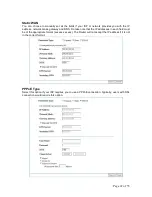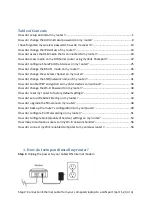
Page 9 of 55
Wireless LAN Basics
A Wireless LAN (WLAN) is a computer network that transmits and receives data with radio
signals instead of using cables. WLANs have become common in homes, offices, airports and
public Hotspots. WLAN can support the same applications and software that run on a wired
network (LAN). Besides supporting the same software and functions, WLAN brings greater
convenience and eliminates the need to lay Ethernet cables in a home or office.
The Router is based on the finalised 802.11g standard. The IEEE 802.11g standard is an
improvement on the 802.11b (WiFi) standard. It increases the data rate up to 54 Mbps within the
2.4GHz band. As the 802.11b standard is also using the 2.4GHz frequency band, the product is
fully backward compatible with the older 802.11b devices. WiFi cards can be used to connect to
the Router at 11Mbps.
The Router can even support 108Mbps WLAN if the user is using a recommended Turbo-capable
Cardbus.
The Router is also known as the Wireless Access Point (AP). The PC using the Cardbus is
known as the Client. WLAN networking involves a few additional parameters to be configured:
SSID
The SSID is the “network name” for the WLAN network. The SSID is any name, and can be any
set of characters or numbers, and must be configured on both the AP and Client. The Client sniffs
the radio frequencies for an AP with the same SSID with itself. The client locks onto the AP and
they are “associated”.
To enable plug-and-play convenience, most client cards can sniff the frequencies to extract the
available SSIDs to let the user choose from. Alternatively, setting the client’s SSID to “ANY” can
allow it to connect to most APs regardless of the AP’s SSID setting.
Encryption
WLAN traffic can be captured by anybody to be read! The solution is to use encryption to make
the traffic appear as random characters to the eavesdropper. Both the AP and client must use the
same encryption standard and key to enable them to decode the “rubbish”. If the encryption
settings are mismatched, the client and AP cannot associate. WEP (Wired Equivalent Privacy) is
the most common WLAN encryption standard.
MAC Address Control
Every client card has a unique MAC Address. This MAC Address can be input into the AP
(Router), such that the AP only allows this pool of MAC Addresses to use the WLAN.
Channel
There are a total of 11 channels in the 2.4GHz band. Depending on regulation, not all the
frequencies may be available in every country. Frequency is configured on the AP only. The client
searches for the AP and locks onto that AP’s channel.
Signal Strength
Radio signals drop in power over a distance. Even if all the settings are correct, a low signal
strength makes association impossible. The usable distance between the AP and client can
range from a few meters indoor to 200m outdoors maximum. When setting up the AP, make sure
that you:










































